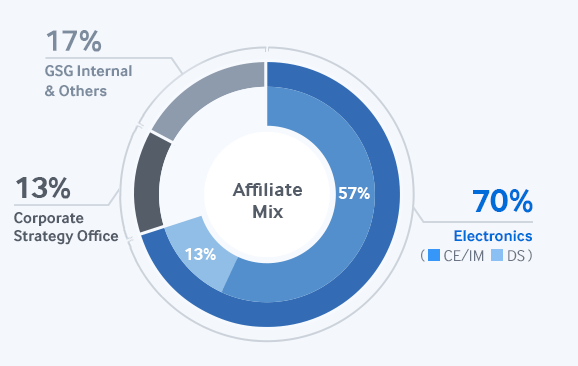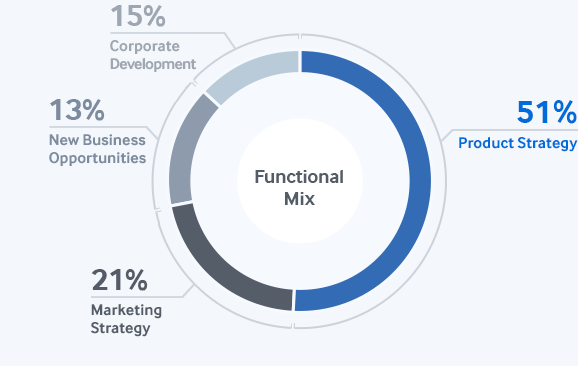GSG
Our Work

Project Portfolio
-

※ CE : Consumer Electronics / IM : IT & Mobile Communications / DS : Device Solutions
- Affiliate Mix
- Electronics (CE/IM 46% + DS 14%) - 60%
- Engineering & Heavy Industry - 20%
- Finance - 11%
- Group & Others - 9%
-

- Functional Mix
- Business & Product Strategy - 38%
- Marketing (Channel 11% + PR 10% + Region9%) - 30%
- New Biz - 13%
- HR & Group - 11%
- Others - 8%
Project Type
-

- Product and Service Strategy
- Content and service strategy
- Growth strategy
- Platform strategy
- Product planning
- Business process improvement
- Retail and channel management
-

- Sales
and GTM - Retail and channel management
- Supply chain analysis
- Channel strategy
- Product launch strategy
- New market entry strategy
- Sales
-

- Marketing
Strategy - Advertising and brand management
- B2B Marketing
- Channel development
- Communication strategy
- Consumer marketing
- Market assessment and sizing
- Marketing PR and communications
- Marketing
-

- Investments
/M&A - Business model development
- M&A and JV target identification
- New venture/product feasibility analysis
- New product and service introduction
- Partnership strategy
- Trend analysis
- Investments
Case Study
-
Domestic Appliances - Samsung Open Home
MoreSamsung Domestic Appliances (DA) asked GSG to execute the worldwide rollout of its Samsung Open Home initiative. The Samsung Open Home is a shop-in-shop concept that showcases DA’s premium collection at major retailers such as Best Buy, Dixons and Media-Saturn. Similar to shop-in-shop’s that showcase Samsung’s visual displays and smartphones, Samsung Open Home goes one step further by incorporating premium floor models, specifically trained salespeople and an 85-inch interactive display. The 85-inch interactive display, referred to as “CenterStage”, provides an interactive virtual store of Samsung’s DA products.
Concentrating on the European market, the GSG team began by analyzing the DA market and identifying stores that would benefit most from a Samsung Open Home investment. Approaching each investment from a profitability and strategic perspective, GSG worked with six European subsidiaries to determine which stores had the greatest ROI potential and best brand positioning, as Samsung was a relative newcomer compared to its competitors. Once the right stores were identified, GSG developed a roll-out plan to ensure that the Samsung Open Home initiative, from concept to installation, remained on track.- Purpose
- Samsung Domestic Appliances (DA) asked GSG to execute the worldwide rollout of its Samsung Open Home initiative.
- The Samsung Open Home is a shop-in-shop concept that showcases DA’s premium collection at major retailers such as Best Buy.
- Outcome & Benefit
- GSG created a detailed model that allowed European subsidiaries to determine the store level profitably for each Samsung Open Home investment.
- GSG developed a detailed road-map for Samsung DA to ensure a successful and timely rollout of the Open Home initiative.
- Background
- The Samsung Open Home initiative is a key component of Samsung's Smart Home concept.
- In the DA market, Samsung is a relatively new entrant with low brand recognition.
- Key Success Factors
- The GSG team worked closely and collaboratively with executives in each subsidiary, establishing common objectives for the project and shaping detailed recommendations and action plans.
-
Samsung Networks
MoreSamsung's Networks division engaged GSG to assess the state of the infrastructure, software and services market for mobile telecom operators in developing regions, e.g., Latin America, Middle East and Africa. With the advent of 5G technology, Samsung Networks has grown to become a significant player and its top management is considering its next strategic moves.
During this 8-weeks engagement, GSG developed an in-depth analysis of local and regional markets, a benchmarking of key competitors' strategies, and a go-to-market strategy covering all offerings to telecom operators. GSG then investigated the opportunity of entering three specific markets, resulting in operational recommendations on how to enter these markets organically and inorganically, including a break-even analysis.- Purpose
- Understand local and regional mobile telecom operators context, map competitors offerings and weaknesses, to prioritize opportunities to grow 4G/5G footprint and acquire new customers.
Recommend which markets to enter and go-to-market strategy. - Outcome & Benefit
- GSG developed a comprehensive set of analyses: in-depth regional market understanding, key competitor benchmarking and break-even analysis), leading to market entry recommendations.
- Background
- Samsung Networks has established itself as a worldwide player of 4G/5G solutions for mobile telecom operators.
With the start of 5G rollouts and continuation of investments to increase and densify 4G coverage, Samsung Networks must fully understand which opportunities are at hand and how to capture them. - Key Success Factors
- Interviews with industry experts and market analysts to gain a full understanding of the network equipment provider context.
- Model of Key Success Factors when resorting to organic and inorganic growth.
-
Samsung Gear (Wearable Tech Positioning)
MoreWith the rumors of new wearables being launched and new competitors entering the wearables category every month, Samsung needed to know exactly how to position its next product launch. Wanting to make the launch perfect, the Mobile Marketing team reached out to GSG to gain a fresh perspective on how consumers' perceived wearables, how their tastes had evolved in the recent past and what types of communications appealed to them most. As such, GSG engaged with an agency to co-design and observe focus groups in key geographical markets. Based on the insights gathered from the focus groups, GSG then designed and to administered a consumer survey to quantify the market sizes and appeal of new wearable technology.
- Purpose
- The Mobile Marketing team asked GSG to establish market segmentation and a best practice marketing campaign for selected growth segments in developed and developing countries.
- Outcome & Benefit
- GSG provided the Mobile Marketing team with a clear understanding of which consumers to target, what types of features and use cases they were looking for and how to effectively communicate to them in their upcoming marketing campaign.
- Background
- Samsung is the pioneer in the smartwatch category and the market leader in this category. Wearable technology has a broad definition in the marketplace and tremendous appeal from consumers globally. For Samsung, maintaining its leadership in the wearables space is a high priority as it is a major area of growth and innovation.
- Key Success Factors
- The close project collaboration between GSG and the Mobile Marketing team helped GSG in establishing a feasible and actionable roadmap going forward. The combination of qualitative and quantitative market research solidified our findings to take the future launch to the next level of innovation in the wearables space.
-
SDI ESS Market Growth Strategy
MoreFaced with stronger market competition in its established IT battery segment, SDI asked GSG to analyze the energy storage system (ESS) market, to re-define their current ESS market segmentation and to create new business models for ESS lithium-ion batteries.
Based on an initial analysis the project was split into 2 phases to look at developed and developing countries separately across key indicators like status of ESS regulations, government support and energy grid stability.
GSG then conducted interviews with more than 120 industry experts from more than 80 companies and institutions in the targeted regions. Using expert input GSG established new exclusive segments all along the electricity path and assessed the market size by segment not only for SDI’s technology, but also for its main competing technologies.
This methodology created big waves in the industry and experts considered GSG's approach as groundbreaking and the way to proceed with ESS research to come.
Building up on these results the most promising market segments for SDI’s technology per region / county were selected and dedicated business models were created. As a result of the project SDI implemented GSG’s recommendations in the markets with customized business models.- Purpose
- SDI Planning team asked GSG to establish a new market segmentation for the ESS market and build feasible business models for selected growth segments for developed and developing countries.
- Outcome & Benefit
- GSG established a detailed ESS market segmentation that, according to industry experts, has the potential to become the new industry standard.
- A sophisticated market forecast model has been created that assesses the ESS market until 2020 in MW, MWh and $ for the main technologies in the market.
- Detailed business models have been proposed to directly address the growth segments for SDI in the target regions.
- Background
- SDI is the leader in manufacturing IT lithium-ion batteries and wants to expand this leading edge into other segments.
- Lithium-ion batteries for automotive have been the first expansion area introducing partnerships with several well-known automotive players.
- The ESS segment is considered to be one of the fastest growing markets within the battery industry.
- Key Success Factors
- The close project collaboration between GSG, SDI in Korea and the subsidiaries that helped GSG establishing a feasible and actionable roadmap going forward.
- The great deal of input from industry experts that shared their view with GSG for free to help shaping the industry.
-
Global Partnerships Strategy
MoreSamsung Mobile engaged the Global Strategy Group to create a framework for developing marketing partnerships with leading global companies. The team worked side-by-side with key members of the Mobile Marketing organization to develop and pitch partnership proposals. The intended partnerships ranged in complexity from simple promotions all the way to new product co-development. Given the strength of the Samsung Galaxy brand, Samsung Mobile was looking for strong partners who could make a unique and interesting contribution.
The GSG team worked closely with Samsung Mobile to carefully identify suitable partners based on complementary brand attributes and strategic fit. The team was responsible for developing customized collaboration opportunities for each target partner, being sure to carefully articulate the value proposition both for the partner and, of course, customers. As a direct result of the GSG team’s efforts, Mobile Marketing was able to initiate partnership discussions with leading global companies.- Purpose
- To create mutually beneficial marketing partnerships between Samsung Mobile and leading, global companies in order to achieve multiple benefits for both brands.
- Outcome & Benefit
- The GSG team helped Samsung Mobile to create a framework for addressing marketing partnerships.
- Using this framework, the GSG team developed a target list of companies based on complementary brand attributes and strategic fit.
- After identifying partners, the GSG team developed customized collaboration proposals and initiated discussions with many global target partners which Samsung Mobile has been able to turn into successful marketing partnerships.
- Background
- Given the recognized global strength of the Samsung Galaxy brand, Samsung Mobile took on the initiative to create marketing partnerships with global, leading companies.
- Given the variety and complexity of such partnerships, it was imperative for Samsung, an attractive partner with a unique position, to create proposals that were compelling for potential partners and customers.
- Key Success Factors
- Creating a win-win situation with partnership proposals, with a focus on enhancing the partner’s brand values and positioning, business objectives, and customer experience.


